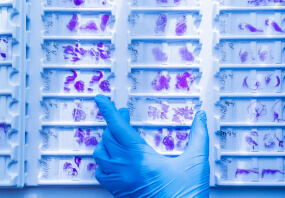General description
Cluster of differentiation 209 (CD209), also known as dendritic cell-specific intercellular adhesion molecule-3-grabbing non-integrin (DC-SIGN), is part of the innate immune system. It is expressed by intestinal dendritic cells and alveolar macrophages. The gene encoding this C-type lectin contains seven exons and is localized on human chromosome 19p13.2.
This gene encodes a transmembrane receptor and is often referred to as DC-SIGN because of its expression on the surface of dendritic cells and macrophages. The encoded protein is involved in the innate immune system and recognizes numerous evolutionarily divergent pathogens ranging from parasites to viruses with a large impact on public health. The protein is organized into three distinct domains: an N-terminal transmembrane domain, a tandem-repeat neck domain and C-type lectin carbohydrate recognition domain. The extracellular region consisting of the C-type lectin and neck domains has a dual function as a pathogen recognition receptor and a cell adhesion receptor by binding carbohydrate ligands on the surface of microbes and endogenous cells. The neck region is important for homo-oligomerization which allows the receptor to bind multivalent ligands with high avidity. Variations in the number of 23 amino acid repeats in the neck domain of this protein are rare but have a significant impact on ligand binding ability. This gene is closely related in terms of both sequence and function to a neighboring gene (GeneID 10332; often referred to as L-SIGN). DC-SIGN and L-SIGN differ in their ligand-binding properties and distribution. Alternative splicing results in multiple variants.
Immunogen
CD209 (NP_066978.1, 1 a.a. ~ 404 a.a) full-length human protein.
Sequence
MSDSKEPRLQQLGLLEEEQLRGLGFRQTRGYKSLAGCLGHGPLVLQLLSFTLLAGLLVQVSKVPSSISQEQSRQDAIYQNLTQLKAAVGELSEKSKLQEIYQELTQLKAAVGELPEKSKLQEIYQELTRLKAAVGELPEKSKLQEIYQELTWLKAAVGELPEKSKMQEIYQELTRLKAAVGELPEKSKQQEIYQELTRLKAAVGELPEKSKQQEIYQELTRLKAAVGELPEKSKQQEIYQELTQLKAAVERLCHPCPWEWTFFQGNCYFMSNSQRNWHDSITACKEVGAQLVVIKSAEEQNFLQLQSSRSNRFTWMGLSDLNQEGTWQWVDGSPLLPSFKQYWNRGEPNNVGEEDCAEFSGNGWNDDKCNLAKFWICKKSAASCSRDEEQFLSPAPATPNPPPA
Biochem/physiol Actions
Cluster of differentiation 209 (CD209) mediates viral infection and activates immune responses. It activates T-cells and aids in their growth. The protein recognizes various pathogens and triggers immunosuppressive reactions. It is involved in the innate immune system. It recognizes numerous evolutionarily divergent pathogens ranging from parasites to viruses that have severe health impacts on humans. CD209/ DC-SIGN mediates the entry of various viruses such as dengue virus, human immunodeficiency virus (HIV), Ebola virus and human cytomegalovirus into the human cells. CD209 acts as an alternative receptor for SARS-CoV-2, a causative agent for the novel coronavirus disease 2019 (COVID-19).
Physical form
Solution in phosphate buffered saline, pH 7.4
Shipping Information:
Dry Ice Surcharge & Ice Pack Shipments: $40
More Information: https://cenmed.com/shipping-returns
- UPC:
- 41106609
- Condition:
- New
- Availability:
- 3-5 Days
- Weight:
- 1.00 Ounces
- HazmatClass:
- No
- MPN:
- SAB1407409-50UG
- Temperature Control Device:
- Yes












